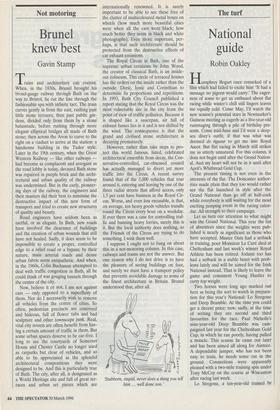Not motoring
Brunel knew best
Gavin Stamp
Trains and architecture can coexist. When, in the 1830s, Brunel brought his broad-gauge railway through Bath on the way to Bristol, he cut the line through the fashionable spa with infinite tact. The train curves gently in from the east, rushing past little stone terraces; then past public gar- dens, divided only from them by a stone balustrade, before rushing through more elegant elliptical bridges all made of Bath stone; then across the Avon to curve to the right on a viaduct to arrive at the station: a handsome building in the Tudor style. Later in the 19th century, when the Great Western Railway — like other railways — had become as complacent and arrogant as the road lobby is today, decayed Bath stone was repaired in purple brick and the archi- tectural and urban quality of the railway was undermined. But in the early, pioneer- ing days of the railway, the engineers and their masters did their best to minimise the destructive impact of this new form of transport and tried to create new structures of quality and beauty.
Road engineers have seldom been as tactful, or as elegant. In Bath, new roads have involved the clearance of buildings and the creation of urban wounds that still have not healed. Sadly, it does seem to be impossible to create a proper, controlled edge to a relief road or a bypass; by their nature, main arterial roads and dense urban fabric seem antipathetic. And when, in the 1960s, Colin Buchanan attempted to deal with traffic congestion in Bath, all he could think of was gouging tunnels through the centre of the city.
Now, believe it or not, I am not against cars — only opposed to a superfluity of them. Nor do I necessarily wish to remove all vehicles from the centre of cities. So often, pedestrian precincts are contrived and hideous, full of flower tubs and bad sculpture and other townscape junk. Real, vital city streets are often benefit from hav- ing a certain amount of traffic in them. But some urban spaces deserve to be car-free. I long to see the courtyards of Somerset House and Chester Castle no longer used as carparlcs but clear of vehicles, and so able to be appreciated as the splendid architectural compositions they were designed to be. And this is particularly true of Bath. The city, after all, is designated as a World Heritage site and full of great ter- races and urban set pieces which are
internationally renowned. It is surely important to be able to see these free of the clutter of multicoloured metal boxes on wheels (how much more beautiful cities were when all the cars were black; how much better they seem in black and white photographs). Even more important, per- haps, is that such architecture should be protected from the destructive effects of car exhaust emissions.
The Royal Circus in Bath, one of the supreme urban creations by John Wood, the creator of classical Bath, is an inside- out coliseum. This circle of terraced houses has the orders on the inside rather than the outside: Doric, Ionic and Corinthian to determine its proportions and repetitions. In 1993, Bath City Council published a report stating that the Royal Circus was the most vulnerable site in the city from the point of view of traffic pollution. Because it is shaped like a saucepan, air full of exhaust fumes lies in it and is not shifted by the wind. The consequence is that the grand and civilised stone architecture is decaying prematurely.
However, rather than take steps to pro- tect this world famous, listed, celebrated architectural ensemble from decay, the Con- servative-controlled, car-obsessed council has actually managed to divert yet more traffic into the Circus. A recent survey found that of the 5,000 vehicles that roar around it, entering and leaving by one of the three radial streets that afford access, only 1.5 per cent have business in the Royal Cir- cus. Worse, and even less excusable, is that, on average, ten heavy goods vehicles trundle round the Circus every hour on a weekday. If ever there was a case for controlling traf- fic and banning heavy lorries, surely this is it. But the local authority does nothing, so the Friends of the Circus are trying to do something. I wish them well.
I suppose I ought not to bang on about this in a not-motoring column. In this case, railways and trams are not the answer. But one reason why I do not drive is to have the pleasure of seeing buildings on foot, and surely we must have a transport policy that prevents avoidable damage to some of the finest architecture in Britain. Brunel understood that, after all.
'Stubborn, stupid, never does a thing you tell him ... well done son.'


























































 Previous page
Previous page